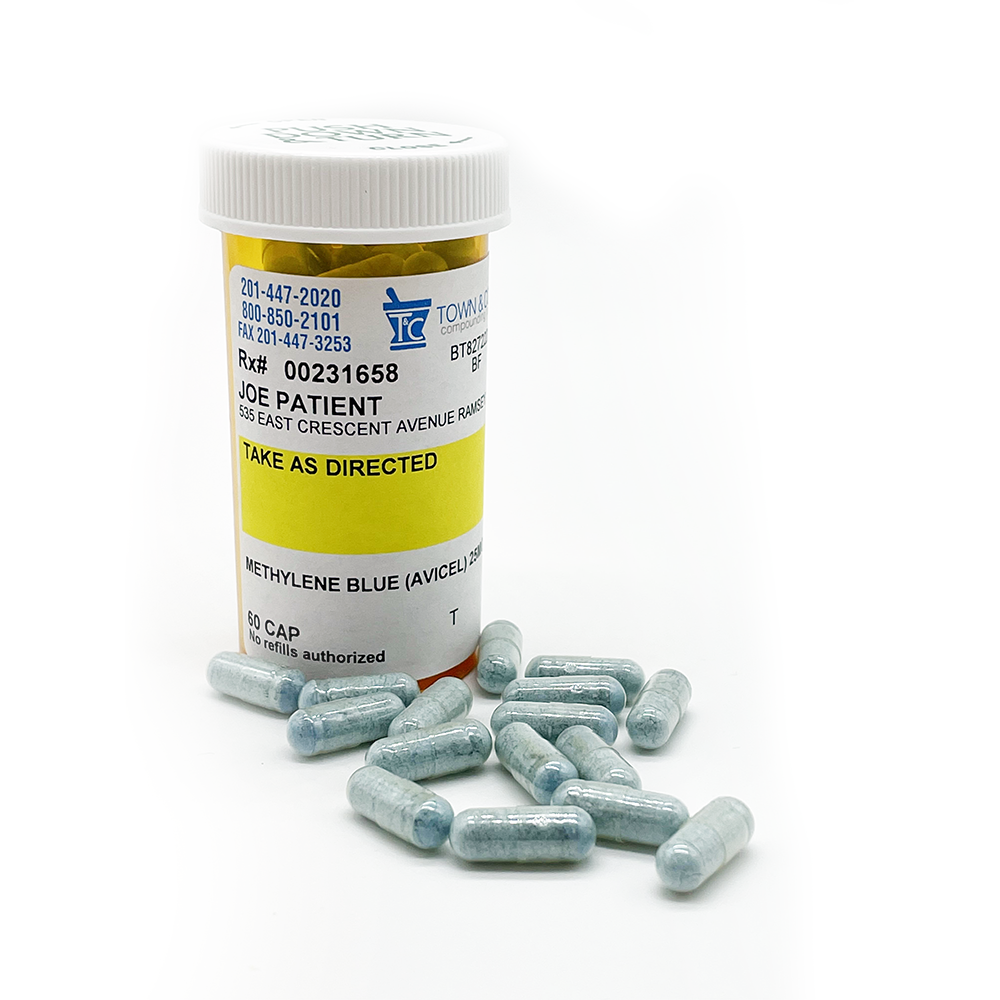
Methylene Blue and Alzheimer's Disease; Research
by Dr. Francisco Gonzales-Lima, Ph.D.
Methylene Blue Capsules

Methylene Blue Capsules require a prescription. For prescribers, please see our Rx order form. For more information, please call or text us at 201-447-2020.
Methylene Blue and Alzheimer's Research
John Herr, RPh explains the how Methylene Blue works in the body and proper usage.
As of now, there are nearly 50 million people living with dementia with a prediction of 75 million by 2030. There is an enormous need for new disease-modifying therapies to tackle this Alzheimer’s Disease (AD).
Most current therapeutic approaches focus on management of behavioral symptoms or attempting to slow the progress of the disease, but none of these solutions modify the unavoidable course of the disease.
Many people have family members with AD and wonder why there haven’t been any solutions that actually improve behavior or truly preserve the memory loss of their loved ones. They also wonder if this will be their future also. How can they prevent, slow, or reverse the disease? It’s a devastating disease to witness, and often, people are looking for additional things to slow the progress of the disease.
Drug Interactions
Methylene blue may interact with medications that affect serotonin levels and other neurotransmitter systems. Caution is advised when used in combination with the following drug categories:
- SSRIs (Selective Serotonin Reuptake Inhibitors)
- SNRIs (Serotonin-Norepinephrine Reuptake Inhibitors)
- TCAs (Tricyclic Antidepressants)
- MAOs (Monoamine Oxidase Inhibitors)
Problems with Current AD Research
Amyloid deposits became popular as the hypothetical cause of AD. Many companies have spent millions of dollars researching amyloid deposits and developing drug therapies that have mostly targeted amyloid beta (Aβ) and tau tangles.
A brain with Alzheimer’s disease contains two types of abnormal structures: extracellular amyloid plaques and intraneural neurofibrillary tangles. The building blocks are amyloid-β (Aβ) peptides for plaques and tau for tangles. The behavioral symptoms in a patient with AD correlate with the increasing level of plaques and tangles. Learn more >>
These are not the best targets for drug therapies for late-onset Alzheimer’s disease, according to one of the world’s leading neuroscientists, Dr. Francisco Gonzalez-Lima, Ph.D.
The issue with amyloid and tau neurofibrillary tangles is that they are consequences of AD and neurodegenerative changes, not causes.
They are what you see after years of the degeneration process already happening in the brain. Aβ and tau will show up in all seniors eventually, and the damage to the brain is already done by the time it appears.
One can try to clean up all the deposits, but it will have no relevance for any symptoms of AD. It makes no difference in the outcomes; the drug efforts have been wasted. Why? Because there is no relationship of the current drug therapies with cytochrome oxidase inhibition; Aβ and tau are pathological signs of having a disease.
Drug Therapies for Early-Onset vs Late-Onset AD
There are two different types of AD, although patients with either type will eventually exhibit the same types of symptoms such as behavioral changes, confusion, memory loss, and difficulty making decisions.
Early-onset AD is rare, and only up to 5% diagnosed have this type. This occurs in people younger than 65 years. Late-onset AD happens in people over 65 years of age and is the most common form.
“Clinical trials focusing on drugs that modify β-amyloid (Aβ) have not improved the outcome of Alzheimer’s disease (AD). Elevated biomarkers of Aβ and tau may be better for predicting early dementia status, rather than the more common typical later dementia status that is seen in most patients.”
– Taken from β-Amyloid and tau drive early Alzheimer’s disease decline while glucose hypometabolism drives late decline (Hammond et al., 2020)
Research on AD and Cytochrome Oxidase (CO)
One of the world’s experts in neurodegenerative diseases and methylene blue is Dr. Francisco Gonzalez-Lima, Ph.D. His research is conducted through the University of Texas at Austin.
According to Dr. Gonzalez-Lima, most of the conventional wisdom about late-onset AD is wrong. He does not agree with the dated hypothesis that Aβ and tau tangles cause dementia in seniors. Instead, he says the problems occur because of the inhibition of cytochrome oxidase (CO). Biomarkers of neurodegeneration, especially glucose hypometabolism, are better at predicting late-onset AD than the presence of Aβ and tau tangles.

As our bodies age, we have chronic weakening in our circulatory system. This decreases the blood flow (therefore, oxygen supply) to the brain. Crucial to this process is cytochrome oxidase (CO), which is a mitochondrial enzyme that catalyzes a cell reaction vital to aerobic energy production.
Since 95% of the population has late-onset AD, research should be about mitochondrial dysfunction and CO; it is the inability of the brain to use oxygen to prevent oxidative damage.
Dr. Gonzalez-Lima often discusses his research with “fresh brains”.
Dr. Gonzalez-Lima was able to conduct research on brains immediately after death. He used fresh frozen brains from people with AD vs those who did not have AD. He noticed that the brains of those with AD showed a downregulation of cytochrome oxidase at time of death.
Numerous studies have shown that abnormalities in the mitochondria play a part in the development of AD. Mitochondrial dysfunction may lead to neuroinflammation and oxidative stress via various mechanisms, which can be a factor in brain disease. Therefore, there has been interest in therapies that target the mitochondria and that decrease the inflammation or injury caused by oxidative stress.
The Host of the Decoding Superhuman podcast, Boomer Anderson, asked Dr. Gonzalez-Lima if Cytochrome Oxidase (CO) is related to longevity. Dr. Gonzalez-Lima thinks the answer is yes. If you can upregulate CO, you can increase lifespan.
The primary deficiency in patients with AD was a downregulation of CO. This is how Dr. Gonzalez-Lima got interested in studying methylene blue.
Research on Methylene Blue and Its Effects on AD
Methylene blue has shown to be beneficial in animals and limited human studies on mitochondrial function.
*There is a FDA warning for potential drug interaction between methylene blue and serotonergic psychiatric medications. More Information >>
Podcast Interviews with Dr. Francisco Gonzalez-Lima
Drive with Dr. Peter Attia: #38
Francisco Gonzalez-Lima, Ph.D.: Advancing Alzheimer’s disease treatment and prevention — Is AD actually a vascular and metabolic disease?
STEM-Talk: Episode 107
Francisco Gonzalez-Lima discusses methylene blue and near-infrared light as therapies for cognitive disorders.
Decoding Superhuman Podcast
Methylene Blue with Dr. Francisco Gonzalez-Lima and host Boomer Anderson.
Methylene Blue & Cytochrome Oxidase Abstracts and Links
Therapeutic Benefits of Methylene Blue on Cognitive Impairment during Chronic Cerebral Hypoperfusion
“Chronic cerebral hypoperfusion, a risk factor for mild cognitive impairment and Alzheimer’s disease, affects mitochondrial respiration and memory consolidation. Therefore, drugs that improve mitochondrial function may be appropriate cognitive treatments for cerebral hypoperfusion. Methylene blue (MB) crosses the blood-brain barrier and at low doses serves as an electron cycler in the mitochondrial electron transport chain. Previous studies implicate MB in both memory enhancement and neuroprotection…” Read on >>
Methylene Blue Preserves Cytochrome Oxidase Activity and Prevents Neurodegeneration and Memory Impairment in Rats With Chronic Cerebral Hypoperfusion
“Chronic cerebral hypoperfusion in neurocognitive disorders diminishes cytochrome oxidase activity leading to neurodegenerative effects and impairment of learning and memory. Methylene blue at low doses stimulates cytochrome oxidase activity and may thus counteract the adverse effects of cerebral hypoperfusion…” Read on >>
Why would the preservation of cytochrome oxidase be important?
Mitochondria as a target for neuroprotection: role of methylene blue and photobiomodulation
“Mitochondrial dysfunction plays a central role in the formation of neuroinflammation and oxidative stress, which are important factors contributing to the development of brain disease. Ample evidence suggests mitochondria are a promising target for neuroprotection. This review will discuss two widely studied approaches for the improvement of brain mitochondrial respiration, methylene blue (MB) and photobiomodulation…” Read on >>
Methylene blue modulates functional connectivity in the human brain
“Methylene blue USP (MB) is a FDA-grandfathered drug used in clinics to treat methemoglobinemia, carbon monoxide poisoning and cyanide poisoning that has been shown to increase fMRI evoked blood oxygenation level dependent (BOLD) response in rodents. Low dose MB also has memory enhancing effect in rodents and humans…” Read on >>
Multimodal Randomized Functional MR Imaging of the Effects of Methylene Blue in the Human Brain
“To investigate the sustained-attention and memory-enhancing neural correlates of the oral administration of methylene blue in the healthy human brain…” Read on >>
The study concluded that low-dose methylene blue can increase functional MR imaging activity during sustained attention and short-term memory tasks and enhance memory retrieval.
Protection against neurodegeneration with low-dose methylene blue and near-infrared light
“Breakthrough in vivo studies with these interventions suggest that targeting mitochondrial respiration may be beneficial for protection against different types of neurodegenerative disorders. The purpose of this paper is to provide an update on the cellular mechanisms mediating the neuroprotective effects of low doses of methylene blue and near-infrared light, and to argue that the neurotherapeutic benefits of these two different interventions share the same cellular mechanism of action based on stimulation of mitochondrial respiration…” Read on >>
Neurometabolic mechanisms for memory enhancement and neuroprotection of methylene blue
“This paper provides the first review of the memory-enhancing and neuroprotective metabolic mechanisms of action of methylene blue in vivo. These mechanisms have important implications as a new neurobiological approach to improve normal memory and to treat memory impairment and neurodegeneration associated with mitochondrial dysfunction…” Read on >>
Other Related Research
β-amyloid and tau drive early Alzheimer’s disease decline while glucose hypometabolism drives late decline
Clinical trials of drugs targeting Aβ had a 99.6% failure rate within 10 years, and two additional similar drug trials failed in phase three in 2019, This failure rate is among the highest of any disease area and suggests this may not be the correct target for drugs. Read on >>
Energy Hypometabolism in Posterior Cingulate Cortex of Alzheimer’s Patients: Superficial Laminar Cytochrome Oxidase Associated with Disease Duration. Read on >>
Methylene Blue (and TRx0237)
The Alzheimer’s Drug Discovery Foundation has a very thorough summary of the use of Methylene Blue for addressing Alzheimer’s Disease. This article contains possible drug interactions, dosing recommendations, a summary of studies available, and how Methylene Blue can help Alzheimer’s disease. Read on >>
Methylene blue and Alzheimer’s disease
Pharmacology of Methylene Blue for Alzheimer’s disease in detail can be found in this published article. Read on >>
Effects of Methylene Blue in Healthy Aging, Mild Cognitive Impairment and Alzheimer’s Disease (MB2)
There is an active double-blind, placebo-controlled clinical trial studying effects of 2-week and 12-week administration of Methylene Blue on cerebral blood flow, functional connectivity, memory and attention cognitive abilities using fMRI and behavioral measures in healthy aging, mild cognitive impairment (MCI) and mild Alzheimer’s disease (AD) subjects. Read on >>
Preventive methylene blue therapy preserves cognition in mice expressing full-length pro-aggregant human Tau
There was an in vitro study done on mice in 2015. The study result showed that Methylene Blue helped address early stage Alzheimer’s disease. Read on >>
"The safest option is pharmaceutical grade methylene blue, for which you need a prescription.
Never use industrial grade methylene blue (which is often used for cleaning fish tanks), as it is frequently contaminated with heavy metals. Instead, have your physician write you a prescription to a compounding pharmacy. One of the better ones I have found is Town & Country compounding pharmacy."
– Dr. Joseph Mercola, an osteopathic physician known for natural health and alternative medicine.

